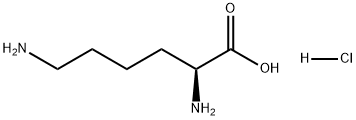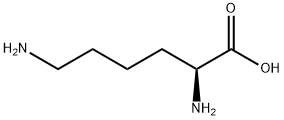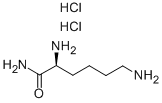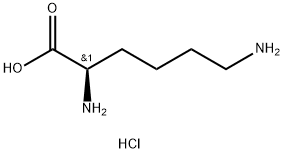L-Lysine hydrochloride
Synonym(s):(S)-(+)-Lysine monohydrochloride;( S) -2,6-Diaminohexanoic acid monohydrochloride;L -Lysine monohydrochloride;L-Lysine monohydrochloride;Lys
- CAS NO.:657-27-2
- Empirical Formula: C6H14N2O2.ClH
- Molecular Weight: 182.65
- MDL number: MFCD00064564
- EINECS: 211-519-9
- SAFETY DATA SHEET (SDS)
- Update Date: 2025-01-27 09:38:02

What is L-Lysine hydrochloride?
Chemical properties
L-Lysine hydrochloride is a white crystalline powder; soluble in water (91.3 mg/ml at 20° C). insoluble in ethanol, acetone, ethyl ether, and benzene. It melts at about 260°C with decomposition. Store at room temperature.
The Uses of L-Lysine hydrochloride
L-Lysine monohydrochloride is widely used as nutritional supplements in food and beverage industries. It can also be used in animal feed as source of L-Lysine.? L-Lysine Monohydrochloride can be used in a wide variety of industries including: food production, beverage, pharmaceutical, agriculture/animal feed, and various other industries.
Definition
ChEBI: L-lysine hydrochloride is the hydrochloride salt of L-lysine It contains a L-lysine.
Biochem/physiol Actions
L-lysine is an essential amino acid in animals and humans. L-Lysine is necessary for protein synthesis in the body and proper growth. L-lysine lowers the cholesterol level by producing carnitine. L-lysine aids in calcium, zinc and iron absorption. Athletes take L-lysine as a supplement for lean mass building and for proper muscle and bone health. L-lysine competes with arginine during viral replication and reduces herpes simplex virus infection. L-lysine supplementation reduces chronic anxiety in human. Lysine reduces viscosity of serum albumin solution for injections.
Benefits
L-Lysine hydrochloride benefits the human body as a source of supplemental lysine, which helps relieve anxiety, prevents bone loss and osteoporosis, promotes healthy skin growth, treats shingles, regulates blood pressure, and prevents arterial plaque build-up, among other effects. In addition, L-Lysine hydrochloride added to feed as a supplement has shown significant effects on broiler weight gain, feed consumption and feed efficiency.
Safety Profile
iWdly toxic by ingestion. When heated to decomposition it emits very toxic fumes of HCl and NOx.
Purification Methods
Likely impurities are arginine, D-lysine, 2,6-diaminoheptanedioic acid and glutamic acid. Crystallise the monohydrochloride from water at pH 4-6 by adding 4 volumes of EtOH. At above 60% relative humidity it forms a dihydrate. [Birhbaum et al. J Biol Chem 194 455, 468 1952, Kearley & Ingersoll J Am Chem Soc 73 5783 1951, Beilstein 4 IV 2717.]
Properties of L-Lysine hydrochloride
| Melting point: | 263 °C (dec.)(lit.) |
| alpha | 21 º (c=8, 6N HCl) |
| Density | 1.28 g/cm3 (20℃) |
| vapor pressure | <1 Pa (20 °C) |
| FEMA | 3847 | L-LYSINE |
| storage temp. | 2-8°C |
| solubility | H2O: 100 mg/mL |
| form | powder |
| color | White to Off-white |
| PH | 5.5-6.0 (100g/l, H2O, 20℃) |
| Odor | odorless |
| optical activity | [α]20/D +20.5±0.5°, c = 5% in 5 M HCl |
| Water Solubility | 65 g/100 mL (20 ºC) |
| λmax | λ: 260 nm Amax: 0.1 λ: 280 nm Amax: 0.1 |
| Merck | 14,5636 |
| BRN | 3563889 |
| Stability: | Stable. Incompatible with strong oxidizing agents. |
| CAS DataBase Reference | 657-27-2(CAS DataBase Reference) |
| EPA Substance Registry System | Lysine hydrochloride (657-27-2) |
Safety information for L-Lysine hydrochloride
| Signal word | Warning |
| Pictogram(s) |
 Exclamation Mark Irritant GHS07 |
| GHS Hazard Statements |
H315:Skin corrosion/irritation H319:Serious eye damage/eye irritation H335:Specific target organ toxicity, single exposure;Respiratory tract irritation |
| Precautionary Statement Codes |
P261:Avoid breathing dust/fume/gas/mist/vapours/spray. P271:Use only outdoors or in a well-ventilated area. P280:Wear protective gloves/protective clothing/eye protection/face protection. |
Computed Descriptors for L-Lysine hydrochloride
L-Lysine hydrochloride manufacturer
ARRAKIS INDUSTRIES LLP
Techno Pharmchem
ASM Organics
New Products
2-Propanamine, 1-chloro-, hydrochloride (9CI) 3-Pyridineacetonitrile, α-hydroxy- 3-Iodophenylacetic acid 3-(hexyloxy)-4-(pyridin-3-yl)-1,2,5-thiadiazole 2-Hexyn-1-ol Dibenzo-18-crown-6 2-Hexanone, 98% Sodium molybdate dihydrate,98% 2,3-Dimethylphenol, 98% 4,4'-Oxydianiline Isoquinoline, 96% 2-Amino-4,6-difluorobenzoic acid, 95% (R)-2-Methylpyrolidine-2-carboxylic acid (De Mepro) Ramipril Sacubitril- Valsartan Boc-his(trt)-OH Fmoc-L-Glu-OtBu Boc-L-Tyr(tBu)-OH N N Dimethylformamide Dimethyl Acetal (Dmf Dma) Semi carbazide Hydrochloride 1-Ethyl-3-(3-Dimethylaminopropyl)-Carbodiimide Hydrochloride [EDC Hcl] Trans-4-Aminocyclohexanol [4tac] 2-[1-(Mercaptomethyl)Cyclopropyl]Acetic Acid 2-Chloromethyl-4-methyl-quinazolineRelated products of tetrahydrofuran








You may like
-
 L-Lysine monohydrochloride 98%View Details
L-Lysine monohydrochloride 98%View Details
657-27-2 -
 L-Lysine Monohydrochloride ExiPlus CAS 657-27-2View Details
L-Lysine Monohydrochloride ExiPlus CAS 657-27-2View Details
657-27-2 -
 L-Lysine Monohydrochloride extrapure CHR CAS 657-27-2View Details
L-Lysine Monohydrochloride extrapure CHR CAS 657-27-2View Details
657-27-2 -
 L-Lysine monohydrochloride CAS 657-27-2View Details
L-Lysine monohydrochloride CAS 657-27-2View Details
657-27-2 -
 L-Lysine monohydrochloride CAS 657-27-2View Details
L-Lysine monohydrochloride CAS 657-27-2View Details
657-27-2 -
 L-(+)-Lysine Monohydrochloride CAS 657-27-2View Details
L-(+)-Lysine Monohydrochloride CAS 657-27-2View Details
657-27-2 -
 L-Lysine Monohydrochloride CAS 657-27-2View Details
L-Lysine Monohydrochloride CAS 657-27-2View Details
657-27-2 -
 L-Lysine hydrochloride 99% CAS 657-27-2View Details
L-Lysine hydrochloride 99% CAS 657-27-2View Details
657-27-2
